William Kentridge on failed utopias and transcending borders: ‘art must defend the uncertain’
Azu Nwagbogu profiles South African artist William Kentridge, whose show at London's Royal Academy of Arts runs until 11 December 2022
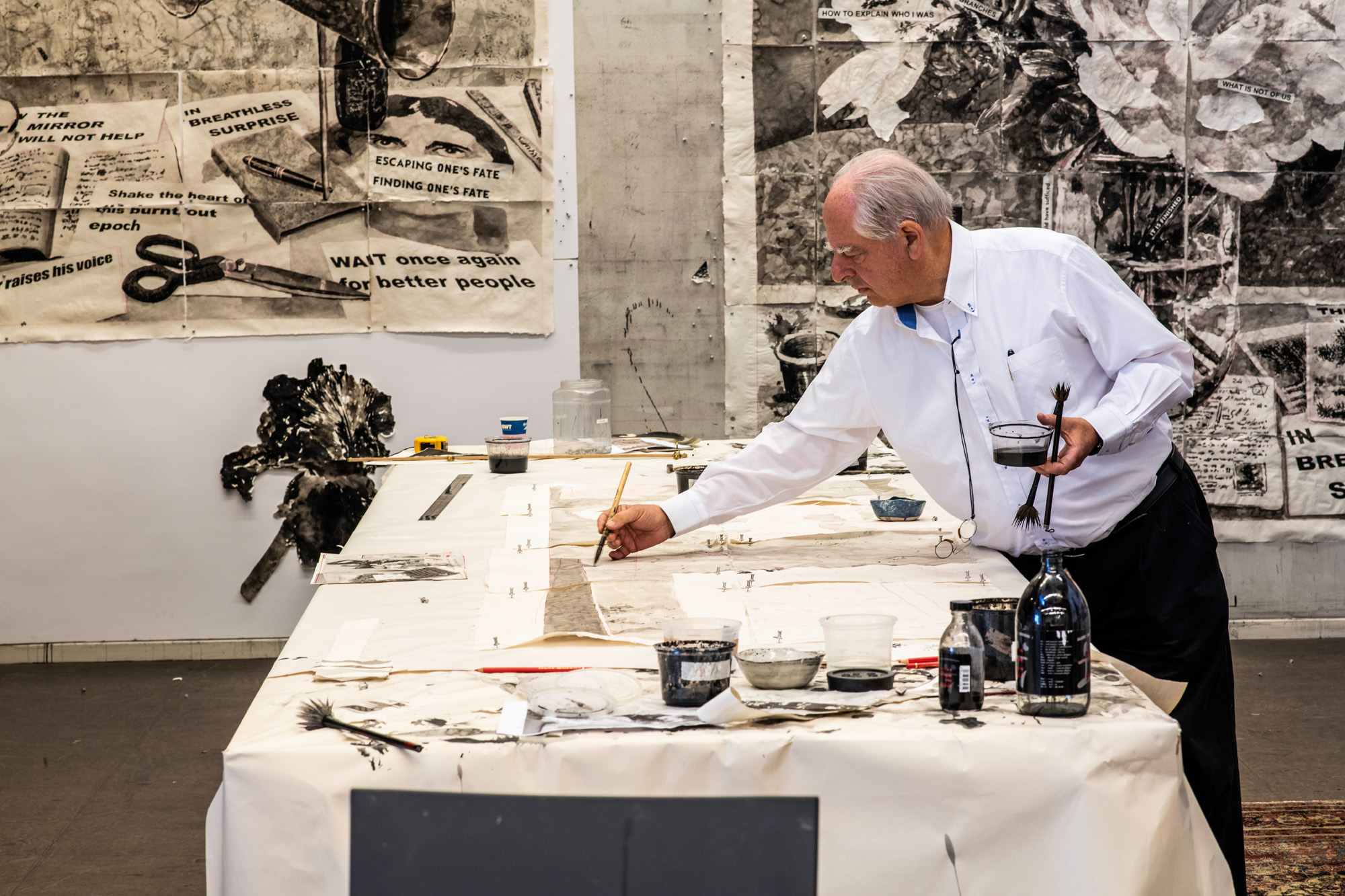
Nico Krijno - Photography
William Kentridge has been a global creative powerhouse for the best part of two decades, yet it feels like he’s only just entering his stride. South Africa’s most influential contemporary artist is the subject of a major exhibition at London’s Royal Academy of Arts, which fills its Main Galleries with works spanning Kentridge’s wide-ranging practice, from drawing, etchings, collage, printmaking, film and sculpture to tapestry, theatre, opera, dance and music. Kentridge’s performative, poetic and literary output mark him out as a Renaissance man, but in a distinctive sense that is at once African – he identifies simply as African – but which also bears traces of his Lithuanian Jewish heritage.
Kentridge was born in Johannesburg in apartheid South Africa in 1955. His father, Sydney Kentridge, became a leading defence lawyer for Black South African leaders in the political trials that dominated international news media during the late 1960s through to the late 1970s. He represented Nelson Mandela during his 1958-1961 treason trial, and in 1978, he gained worldwide acclaim for representing the family of the anti-apartheid activist Steve Biko. Of his performance, Lord Alexander of Weedon wrote: ‘Through remorseless and deadly cross-examination, sometimes with brilliant irony, Kentridge established that the founder of the Black Consciousness Movement had been killed by police brutality. The verdict of accidental death was seen as risible.’
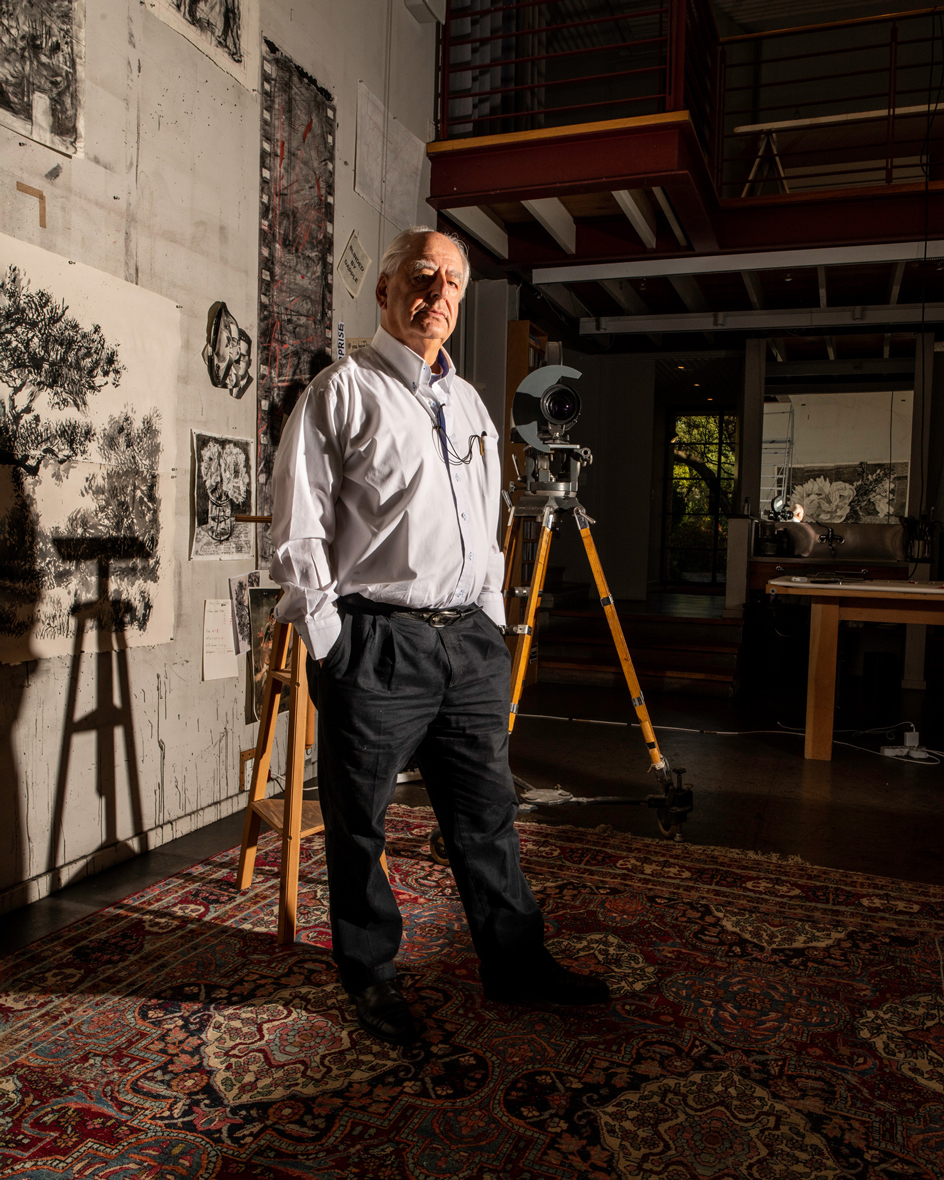
Portrait of South African artist William Kentridge, photographed in July at his studio
Watching his father in court sparked in the young Kentridge an early interest in dramaturgy, politics and history. It led him to acting school, but after graduating, he realised his talents fell short of what was required. When we speak over Zoom in late July 2022, I point out that he always seemed to find success by embracing failure. His response is characteristically blunt: ‘It’s not so much embracing failure. I understand that I’ve always been saved by failures. But each time, it has been a painful failure. It’s not that at the time, I think, “Oh, this is great, it’s failing”. When I couldn’t be an actor, that was very painful. I really thought that’s what I wanted to do, but I was no good at it. When I couldn’t do oil painting, it wasn’t something I celebrated.’ Kentridge still credits his training as an actor for a lot of his success as a visual artist, but only because it crystallised for him that failure is a definite form of knowledge. ‘I can say that a person’s biography shows how one is saved by thorough failures. If you fail a little bit, that’s hard, because you’re not sure whether you should stop or keep going. If you fail thoroughly, then the decision is made for you. It was very clear I was not going to be an actor. It’s not going to be. I became an artist.’
The world is grateful for those saving failures. Acclaim for Kentridge’s work has long since crossed continental boundaries. Indeed, it seems as if there is a museum show on Kentridge every month in some major European, Asian or American city. Suzanne Ackerman, a South African collector who has been collecting Kentridge’s work for the past 25 years, says ‘the versatility of Kentridge’s work is extraordinary and adapts to the relevance of our distressing past, as well as to the hope for a better future on our African continent.’ As leading Nigerian artist Victor Ehikhamenor puts it: ‘William Kentridge is your quintessential polymath. He is an artist who is not limited to a particular material or genre. His dance with both heavy and light art material, as well as his fusion of traditional and technological practice, makes his body of work unique.’ Even Dutch artist Renzo Martens, a gadfly to the art world establishment, whose film and museum projects in Congo have been called ‘ethically troubling’ and ‘politically problematic’, approves of Kentridge. He says, ‘I could say that, in his early animations, he was able to analyse and put to trial the horrors of the apartheid system, not as if it were some outside phenomena, but as something he was part of.’
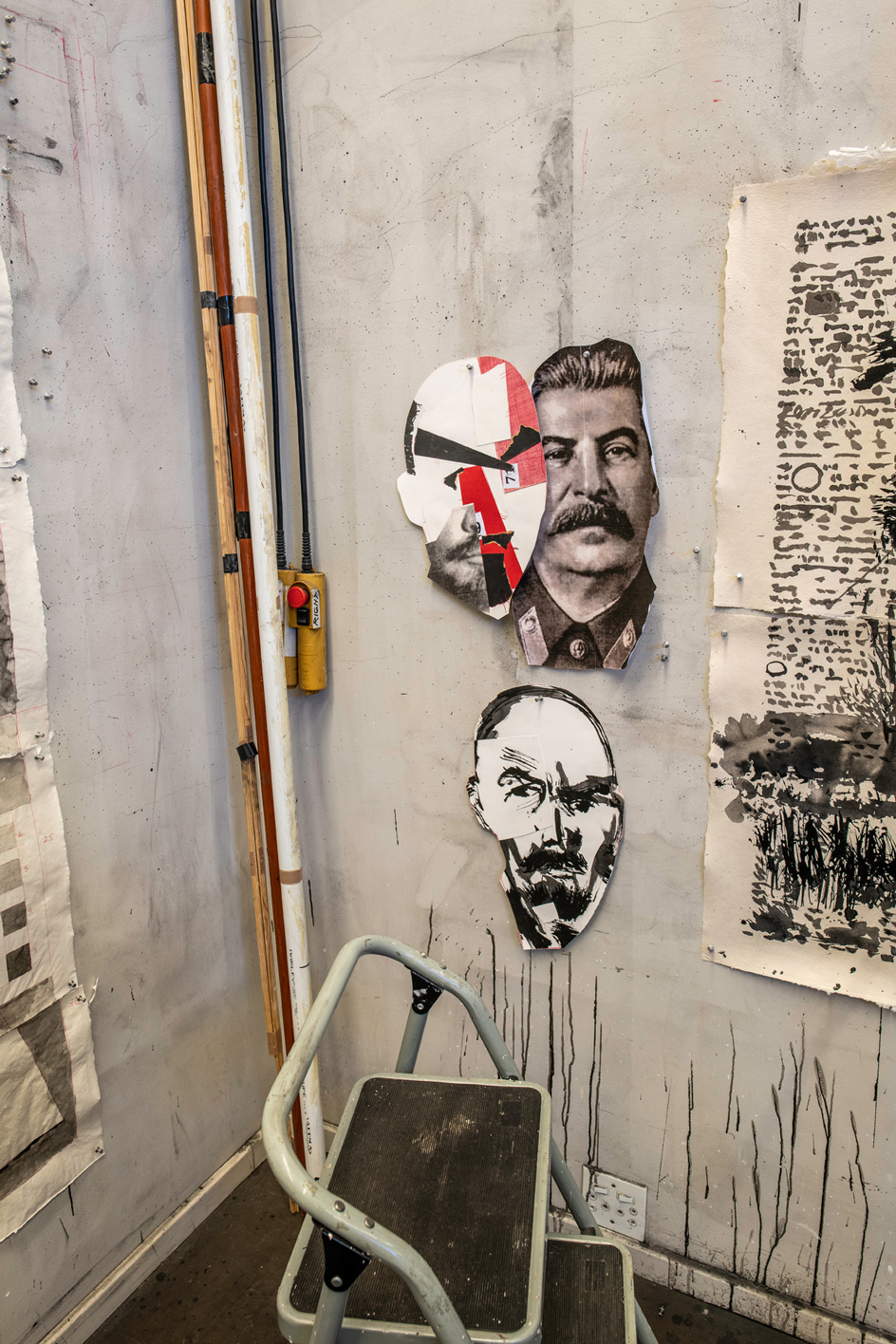
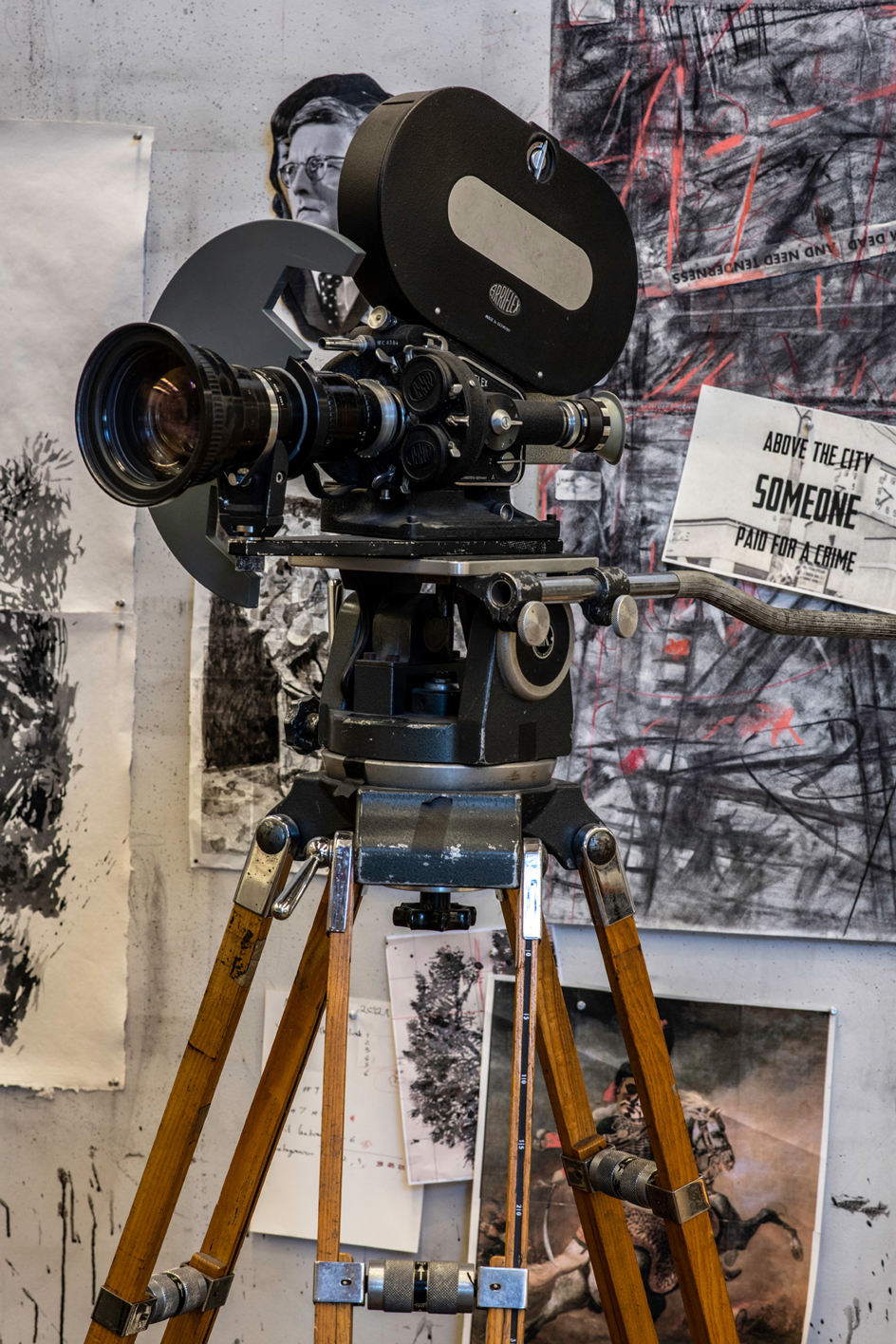
Top: Kentridge’s works in progress for Portraits for Shostakovich Symphony No.10 in E Minor, Opus 93 and a tree drawing in India ink hang on the studio walls. Above: the artist's Arriflex 2C 35mm camera on a wooden tripod
There cannot be many more erudite artists than William Kentridge. During our nearly two-hour conversation, I was reminded of his keen interest in literature, history and music, his philosophical prowess and scientific rigour. The wordsmith in Kentridge has many aphorisms but only one diktat: ‘Art must defend the uncertain’. You do not need to be a Freudian psychologist to diagnose the reason for his love of this epigram. Apartheid South Africa was propagandised with the certainty that the utopia enjoyed by white South Africans would be at risk should freedom be granted to Indigenous South Africans, yet its fanatical last-stand resolve always concealed a corrosive kernel of doubt.
During this era, Kentridge was inspired by another vision of utopia – or of a sanctuary, which he has come to see as the inevitable consequence of all attempts to build human utopias. For a brief period, Black and white South Africans would interact in the context of theatre. He recalls ‘the great days of South African theatre, from the early 1970s to the 1980s. One of the things that happened was this meeting of people who otherwise you would not have met in apartheid, with their racial separation. The theatre, in its very limited way, was a kind of utopian space, where, for those hours, there was a meeting. Obviously, once the evening finished, Black people went home to very different lives. But it became a way of seeing how people could work together and live together in a different structure.’
Kentridge’s work holds a mirror to the limits of human intervention in society, not just in South Africa but across the world
Uncertainty is vital to the curiosity that drives Kentridge. It has led him to interrogate the convictions of political and ideological utopias, and expose how quickly ideology morphs into authoritarian dystopias. His work holds a mirror to the limits of human intervention in society, not just in South Africa but across the world. Kentridge connects geographies through thematic explorations of how history is written. For example, his work with South Africa’s Truth and Reconciliation Commission found resonance in Berlin with the reunification of West and East Germany, and the subsequent opening of the Stasi archives; similarly, in Colombia, with the Civil War and FARC reconciliation after the pronouncement of an end to hostilities and the declaration of amnesty. All of Kentridge’s work that deals with these grand issues begins with a line, a drawing. I had the pleasure of curating his seminal 2019 solo exhibition in Cape Town, ‘Why Should I Hesitate: Putting Drawings to Work’, his most revealing to date. Kentridge turned three large exhibition floors of the Zeitz Museum of Contemporary Art into his studio. Was it a case of the magician revealing his tricks? To experience the exhibition, you realise it is not magic, but the very opposite: it is sleepless nights ruminating and staying with an idea. Image making through a process that begins with mark making or drawing to construct a visual history of the world.
Wallpaper* Newsletter
Receive our daily digest of inspiration, escapism and design stories from around the world direct to your inbox.
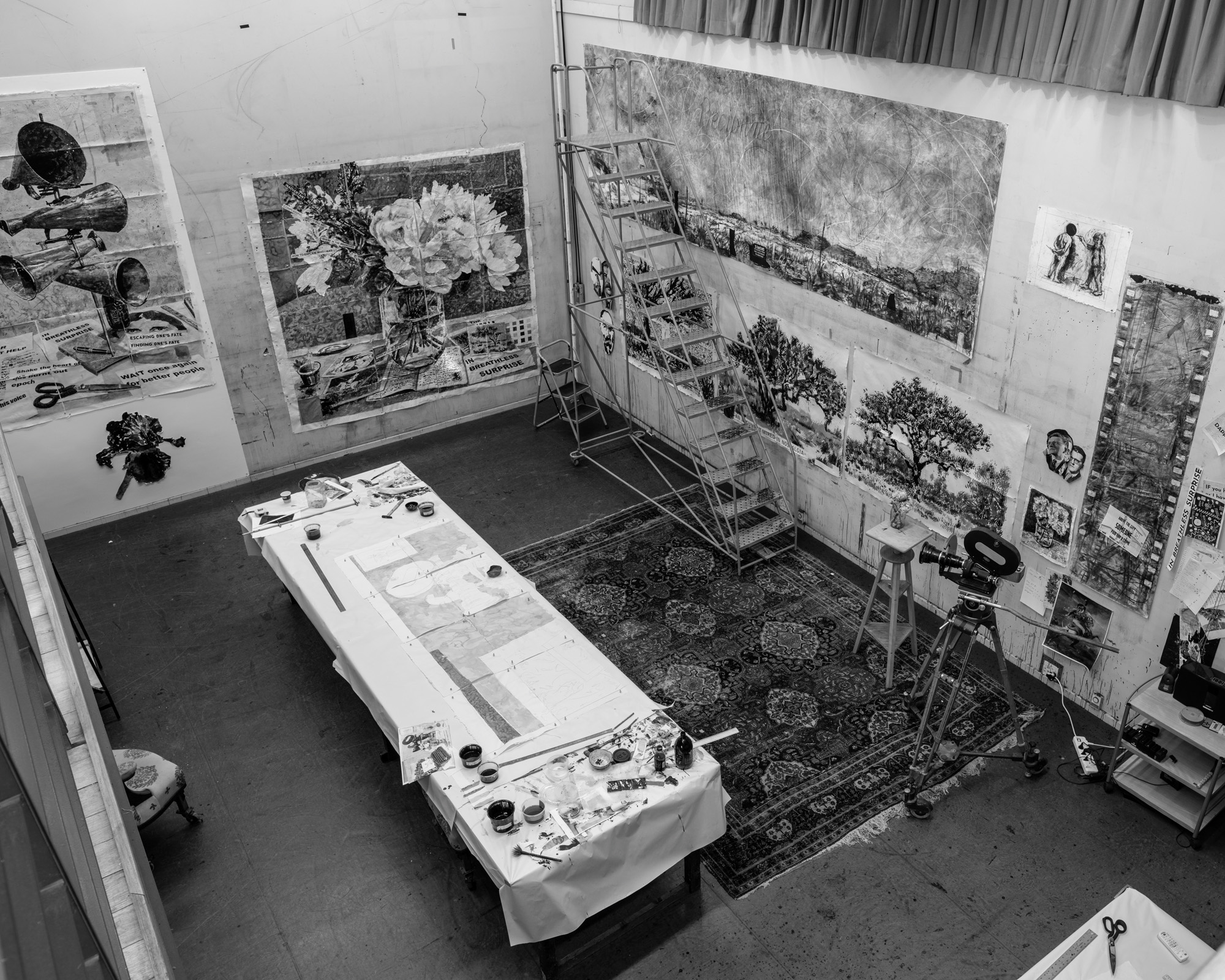
Kentridge's studio in Johannesburg
Kentridge’s solo exhibition at the RA is in a similar vein. ‘It’s very much a view from the studio outwards... the studio is the central point. The animated films [have] never been shown this way before, we’re showing five screens in one room. So you can almost construct your own film by the frames you look at, on the different screens around the space. Even though I’ve made [them] over a period of 30 years, they have a kind of coherence because of the same technique of charcoal drawing.’ Kentridge absorbs ideas from his experiences and harvests these ideas through sheer physical exertion. The combination furnishes him not only with the creative energy required to overcome timidity in addressing the void beyond (the greatest fear of many artists), but also with the stamina to see through to fruition work that explores political and social themes while his own story continues to shift and develop.
Given this thematic complexity, the media and materials called into service in Kentridge’s work are necessarily wide-ranging and protean. The RA exhibition spans a vast array, including two-dimensional artworks in India ink, charcoal, linocut and silkscreen print on paper; kinetic sculptures that evoke the Duchampian readymade tradition; several multi-channel video artworks comprising dozens of projections; and a large-scale installation in the form of an operatic model complete with mechanical puppet actors, titled Notes Towards a Model Opera (2015). The erasure technique adopted for his animated films involves using charcoal to make subtractive and additive drawings on the same sheet of paper, in a way that makes clear that what is being projected is a succession of drawings which retain faint traces of what has been erased. This contrasts with traditional animation, whose seamlessness projects a fantasy verisimilitude. By allowing traces of previous sketches to remain visible, Kentridge maintains the focus on his perennial theme of time and change, and reinforces the protean immediacy that he considers essential to faithfully communicating meaning and quickening the viewer’s memory.
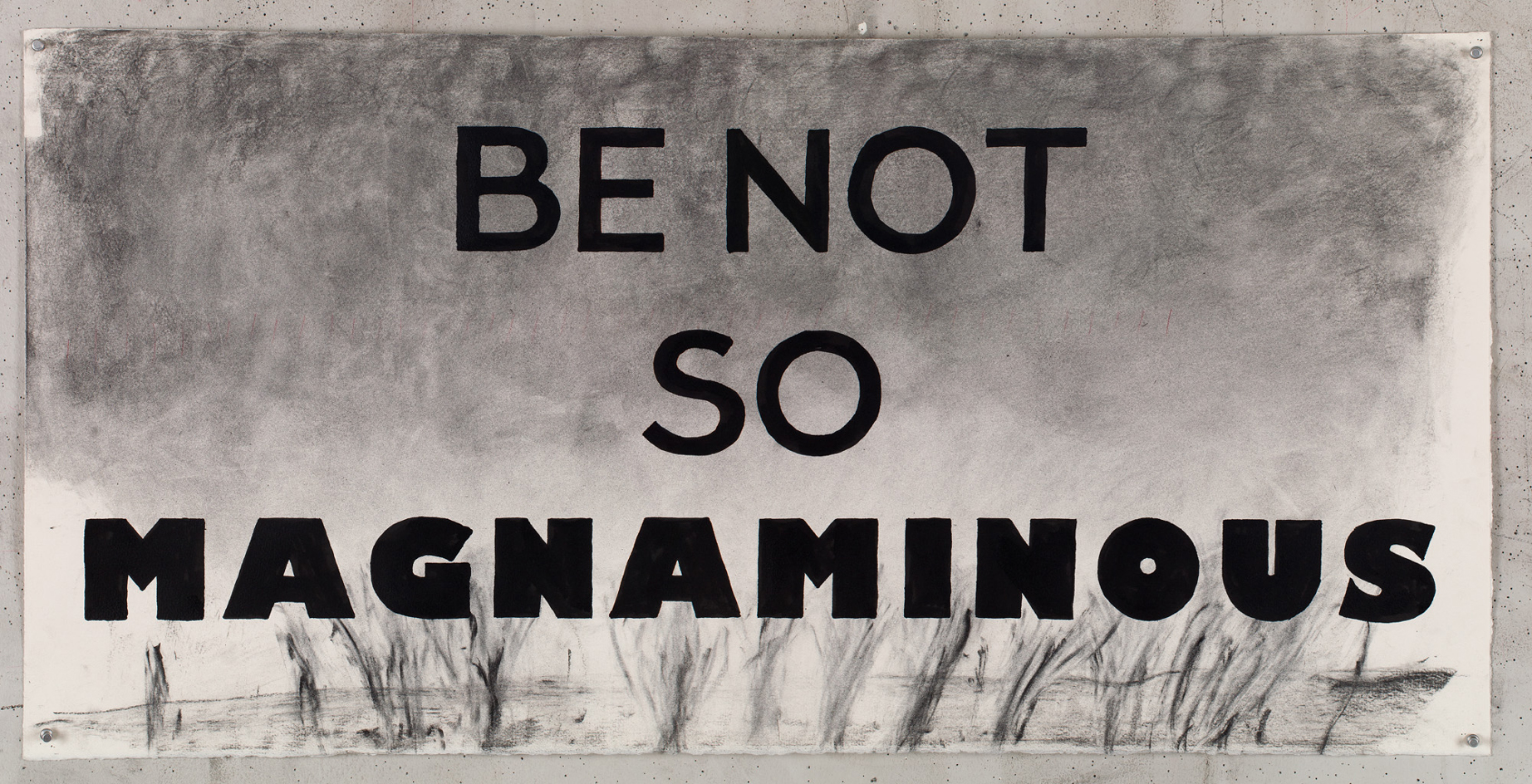
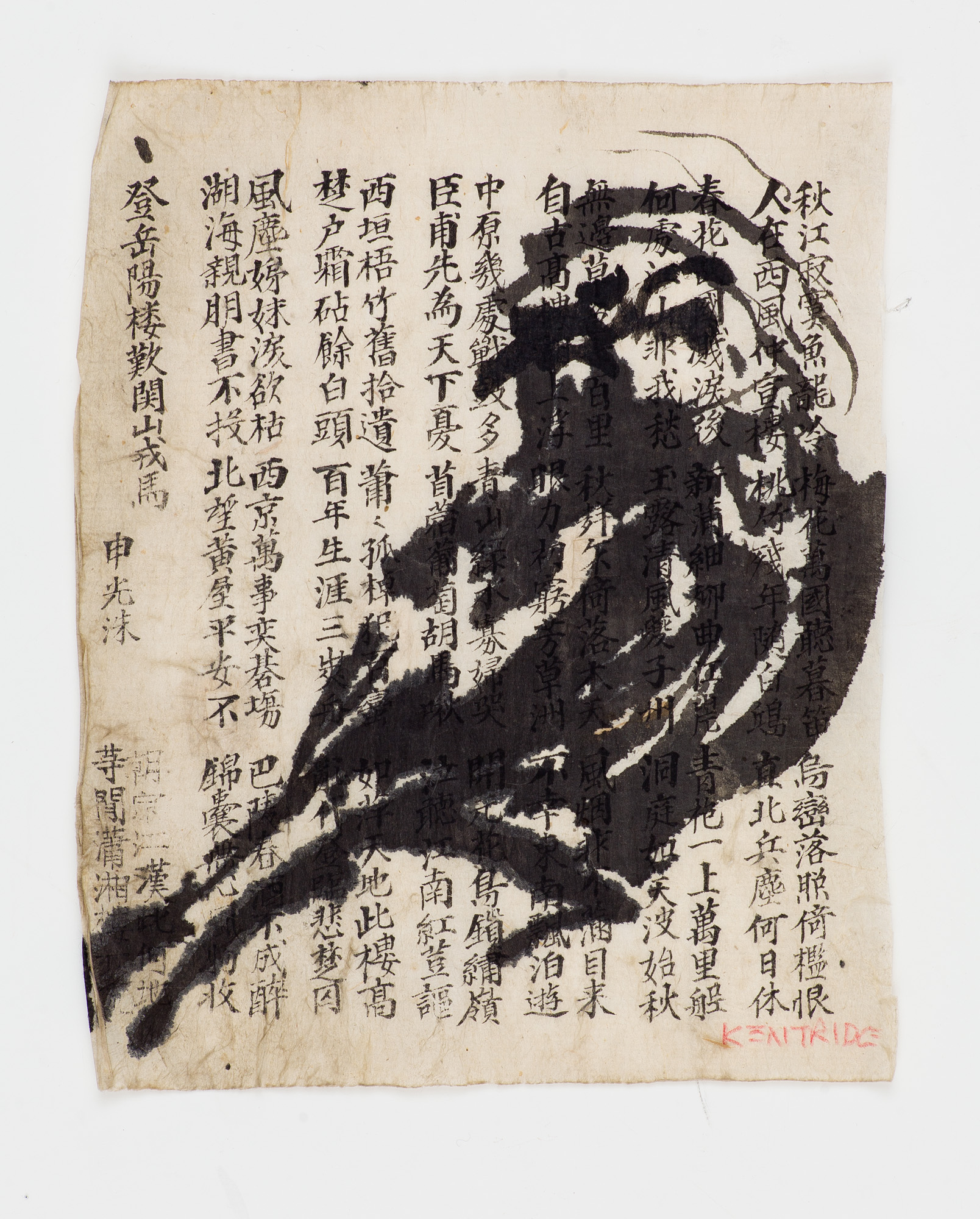
Drawings from Kentridge's Notes Towards a Model Opera. Photography: Thys Dullaart, courtesy of William Kentridge Studio
In Notes Towards a Model Opera, my personal favourite, and the work with the most acute relevance for the present global moment, Kentridge uses the form of the revolutionary operas performed in China during Mao Zedong’s Cultural Revolution to encourage viewers to make a revolutionary imaginative leap across continents and social, political and economic systems, until they are finally able to establish a personal and granular connection. It is rooted in extensive research into the intellectual, political and social history of modern China that Kentridge undertook in preparation for the exhibition when it was originally shown in 2015 at UCCA Beijing. The three-channel projection explores the dynamics of cultural exchange and transformation through the strict formal prism of the Cultural Revolution’s eight model operas.
Among the eight are two didactic ballets, considered both as cultural phenomena in themselves and in the context of a continent- and epoch-spanning history of dance that traverses Paris at the court of the Sun King, Tsarist Moscow, belle époque Shanghai and Kentridge’s native Johannesburg in the 1950s. Notes Towards a Model Opera strips out the didacticism of its model, but nonetheless pays homage to this element in the accompaniment of calligraphic India ink drawings on paper from Chinese books. As in other pieces in which he eschews plain paper for almanacs or documents, Kentridge here underscores his intent of being a cartographer and archivist, enhancing the world’s common store of knowledge. Ancient maps charting the course of this cultural diffusion hint at the historical complexities running alongside this exercise in ‘peripheral thinking’. The dance of Johannesburg mixes with the ballet of China’s revolutionary model operas set to The Internationale, a song which emerged from the defiant squalor of the 1871 Paris Commune. Notes Towards a Model Opera explores the concept of utopias. It is, thematically, quintessential Kentridge.
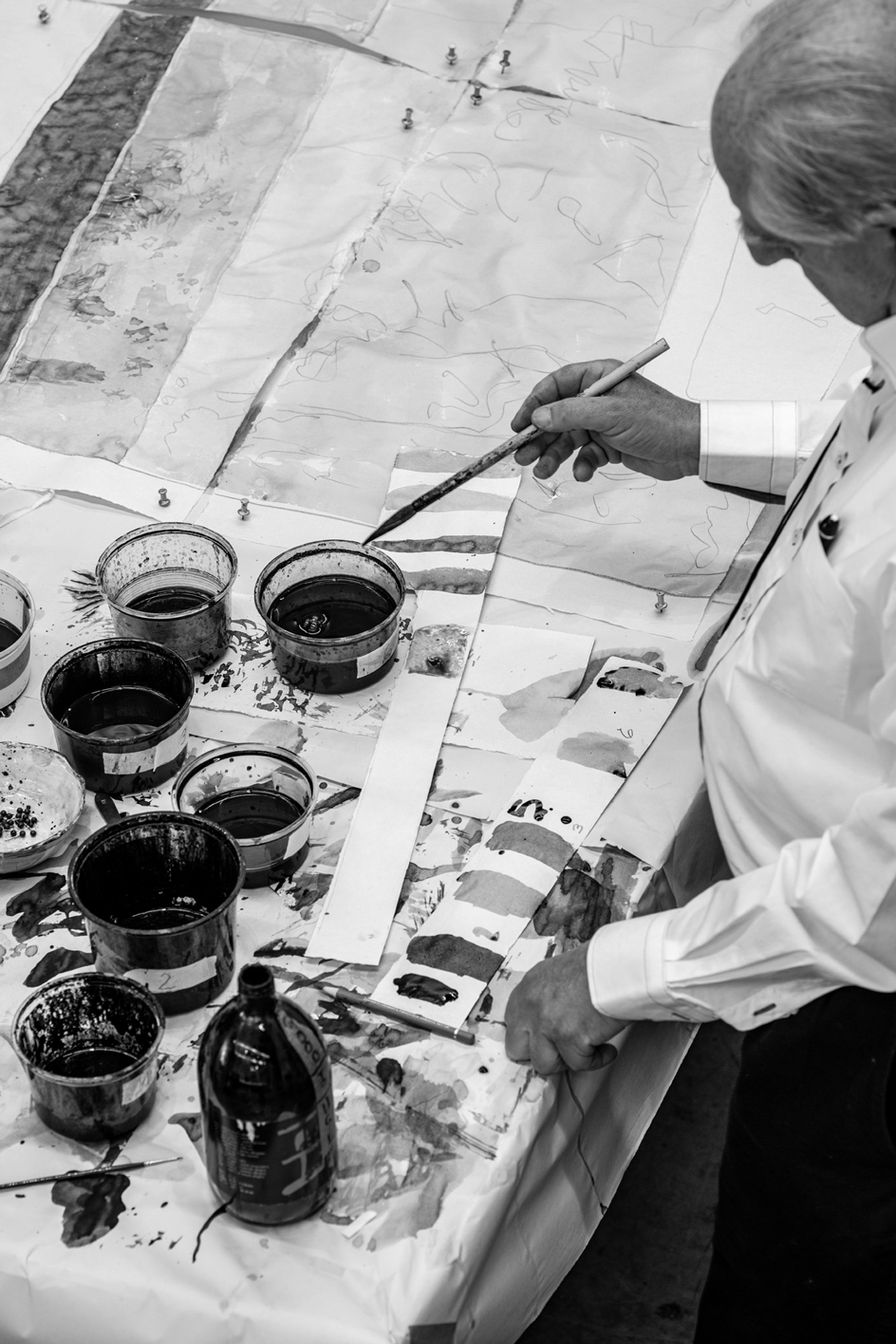
Kentridge at work using India ink on paper
Mao’s disastrous Great Leap Forward campaign was the precursor of the Cultural Revolution, and both failed utopias are embraced in Kentridge’s work. The sparrow cull during the Four Pests campaign as part of the Great Leap Forward caused locusts to proliferate and destroy harvests, leading to a huge decrease in food production and contributing to the famine that led to the death of an estimated 35-45 million Chinese people. In Notes Towards a Model Opera, Kentridge superimposes sparrows in unceasing flight onto pages of the Shuowen Jiezi, a dictionary from the second century. The urgent tapping in the background evokes the banging of pots and pans by ordinary Chinese citizens to prevent the sparrows from landing, which ensured that sparrows that were not shot got no rest and eventually died of stress and exhaustion.
The juxtaposition of China during the Great Leap Forward and South Africa at the inception of apartheid makes the theme of failed utopias and their corresponding sanctuaries hauntingly resonant. Utopia – meaning ‘no place’ – is by definition an unattainable ideal. The fanaticism and certainty that united the instigators of apartheid and the Great Leap Forward are counterbalanced by the uncertainty that shapes the sanctuary Kentridge has created in The Centre for the Less Good Idea, in Johannesburg – an interdisciplinary incubator where doubt and failure can be entertained by artists seeking sanctuary.
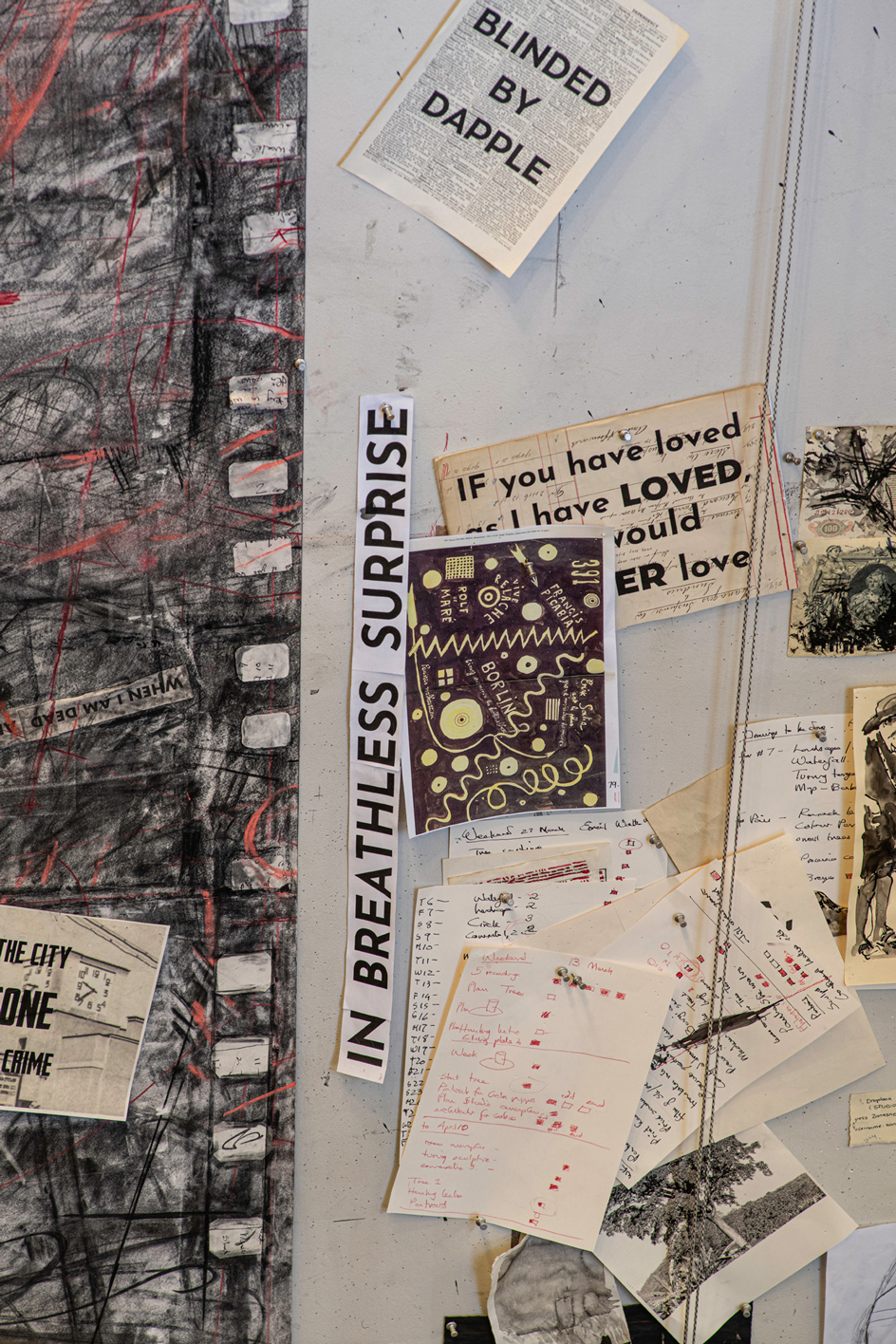
Reference material and works in progress on the walls of Kentridge's Johannesburg studio
The idea of utopia precedes the coiner of the term, Thomas More. Plato’s Republic was a utopia, as was Bacon’s New Atlantis. The People’s Republic of China, like most nominally socialist countries which call themselves republics, is – wittingly or not – saluting Plato. The United States, the world’s capitalist hegemon, also a republic, was founded in line with Bacon’s Great Instauration, as a New World in which Plato’s lost Atlantis would be revived to spur a revival of arts and sciences that would lead to a universal golden age of peace, plenty and prosperity. Kentridge’s work explores the topical confrontation between China and the US, which are failing in contrasting ways. On 8 August 1963, Mao said, ‘I wish to take this opportunity to express our resolute support for the American Negroes in their struggle against racial discrimination and for freedom and equal rights.’ The New York Times described his statement as ‘a formal bid by Peking for leadership of the world’s colored people against the whites’.
Kentridge’s work does an expert, impartial and non-didactic job of showing how words and images are distorted in the beauty parade of contending failed utopias. As we emerge from the current dystopia of the pandemic and live in such uncertain times, Kentridge’s exhibition at the RA seems like a momentous occasion to embrace uncertainty in the hope that it might unearth less perfect ideas to guide our present and future.

Wallpaper* magazine’s October 2022 limited-edition cover features William Kentridge’s Make Me Live Again (2022), which paraphrases a line by the Soviet poet Vladimir Mayakovsky. Photography: Thys Dullaart, courtesy of William Kentridge Studio
INFORMATION
A version of this article appeared in the October 2022 Legends Issue of Wallpaper*, available in print, on the Wallpaper* app on Apple iOS, and to subscribers of Apple News +. Subscribe to Wallpaper* today
- Kentridge’s exhibition is on show from 24 September-11 December at the Royal Academy of Arts, London. royalacademy.org.uk
- 'In Praise of Shadows' runs from 12 November 2022-9 April 2023 at The Broad, Los Angeles. thebroad.org
-
 Put these emerging artists on your radar
Put these emerging artists on your radarThis crop of six new talents is poised to shake up the art world. Get to know them now
By Tianna Williams
-
 Dining at Pyrá feels like a Mediterranean kiss on both cheeks
Dining at Pyrá feels like a Mediterranean kiss on both cheeksDesigned by House of Dré, this Lonsdale Road addition dishes up an enticing fusion of Greek and Spanish cooking
By Sofia de la Cruz
-
 Creased, crumpled: S/S 2025 menswear is about clothes that have ‘lived a life’
Creased, crumpled: S/S 2025 menswear is about clothes that have ‘lived a life’The S/S 2025 menswear collections see designers embrace the creased and the crumpled, conjuring a mood of laidback languor that ran through the season – captured here by photographer Steve Harnacke and stylist Nicola Neri for Wallpaper*
By Jack Moss
-
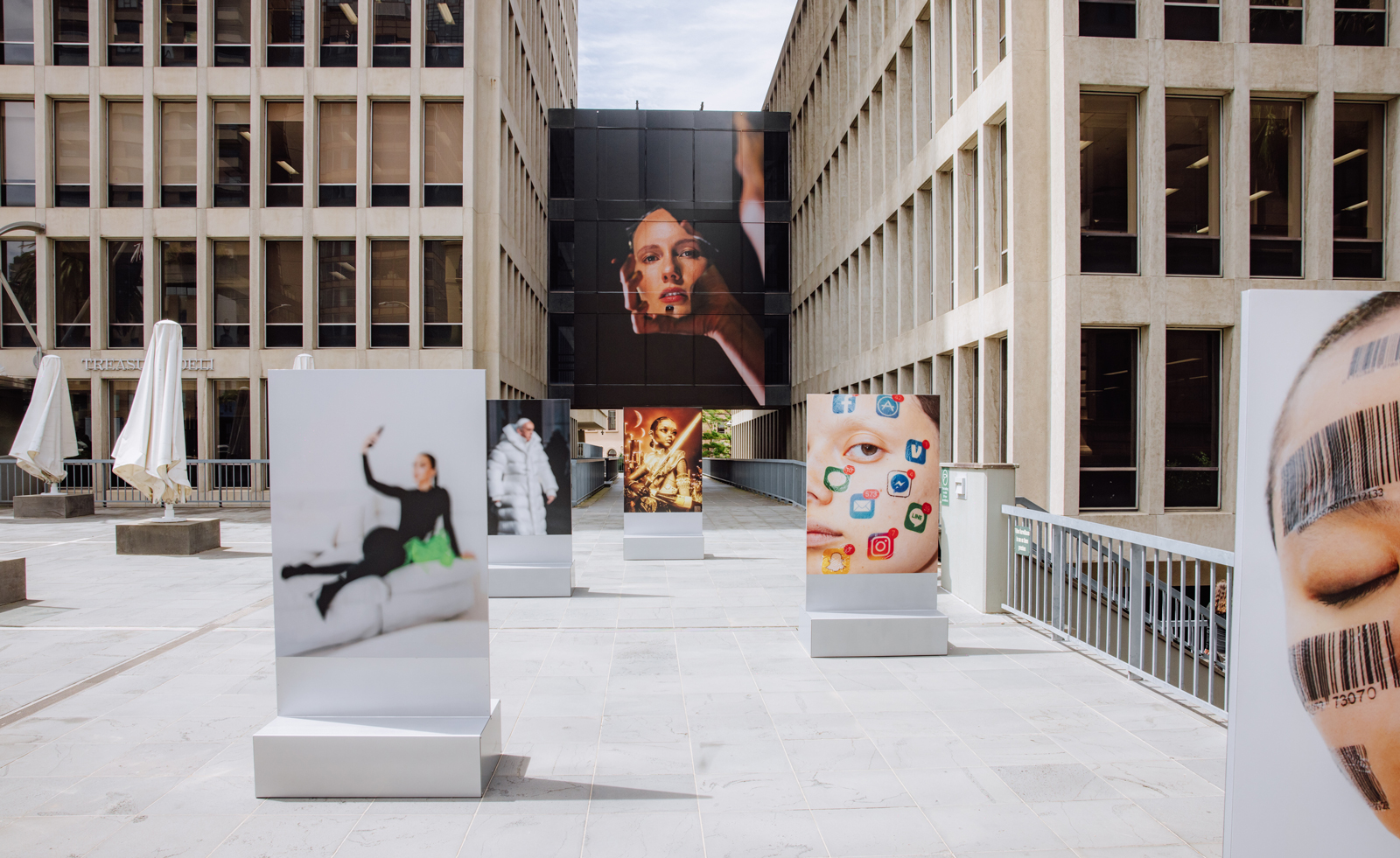 Australia’s first Art Grand Tour unites three biennials in a city-hopping trail
Australia’s first Art Grand Tour unites three biennials in a city-hopping trailAustralia’s Art Grand Tour showcases more than 400 artists, across Sydney, Melbourne and Adelaide in a build-your-own art adventure
By Hannah Silver
-
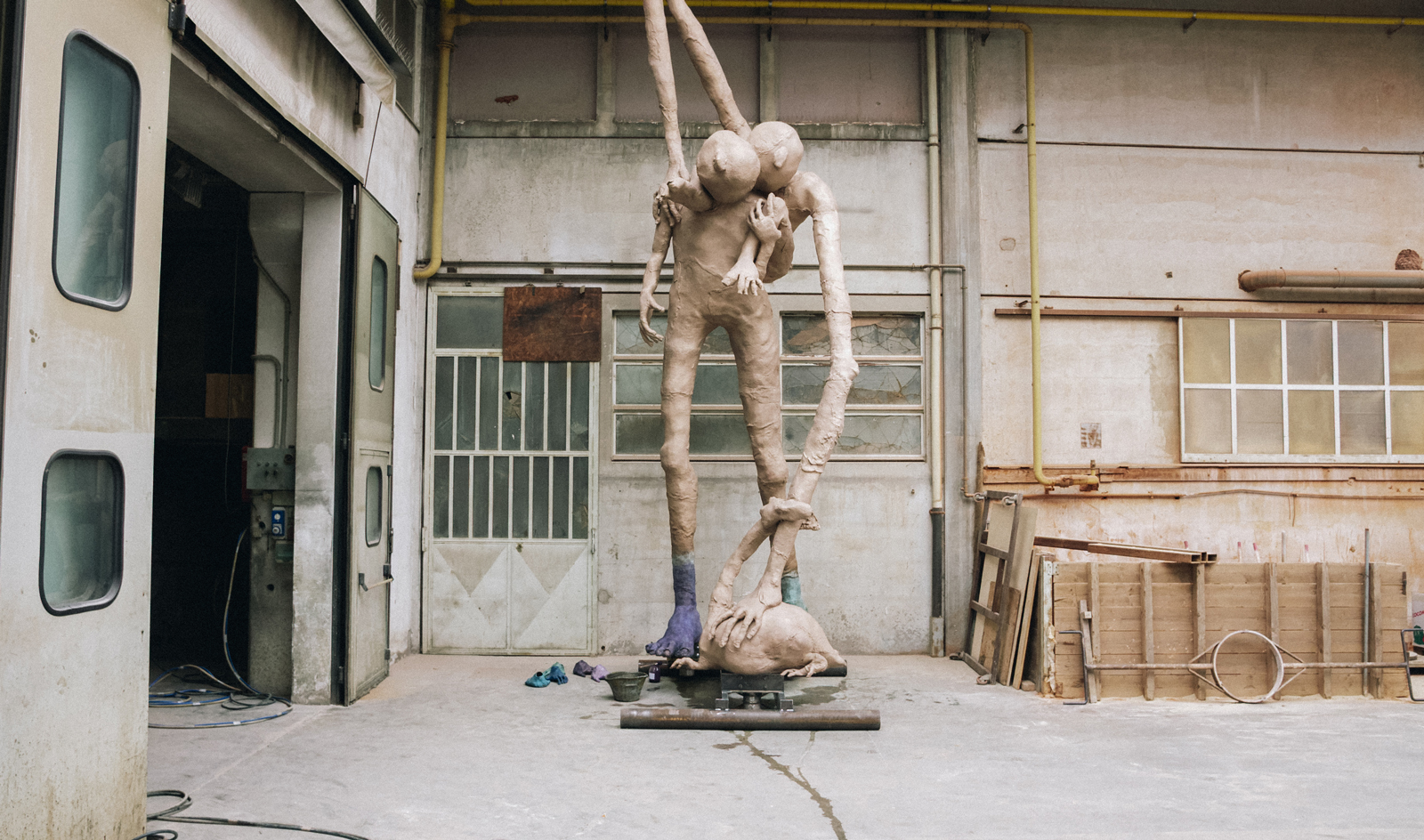 Francis Upritchard blends science fiction and folklore in epic new Sydney Modern Project commission
Francis Upritchard blends science fiction and folklore in epic new Sydney Modern Project commissionWe explore the making of Here Comes Everybody, Francis Upritchard’s fantastical bronzes sculptures for the much-anticipated Sydney Modern Project
By Kate Goodwin
-
 2022 Royal Academy Architecture Prize recognises Renée Gailhoustet
2022 Royal Academy Architecture Prize recognises Renée GailhoustetThe 2022 Royal Academy Architecture Prize is awarded to Renée Gailhoustet, with the shortlist for the 2022 Royal Academy Dorfman Award revealed at the same time
By Ellie Stathaki
-
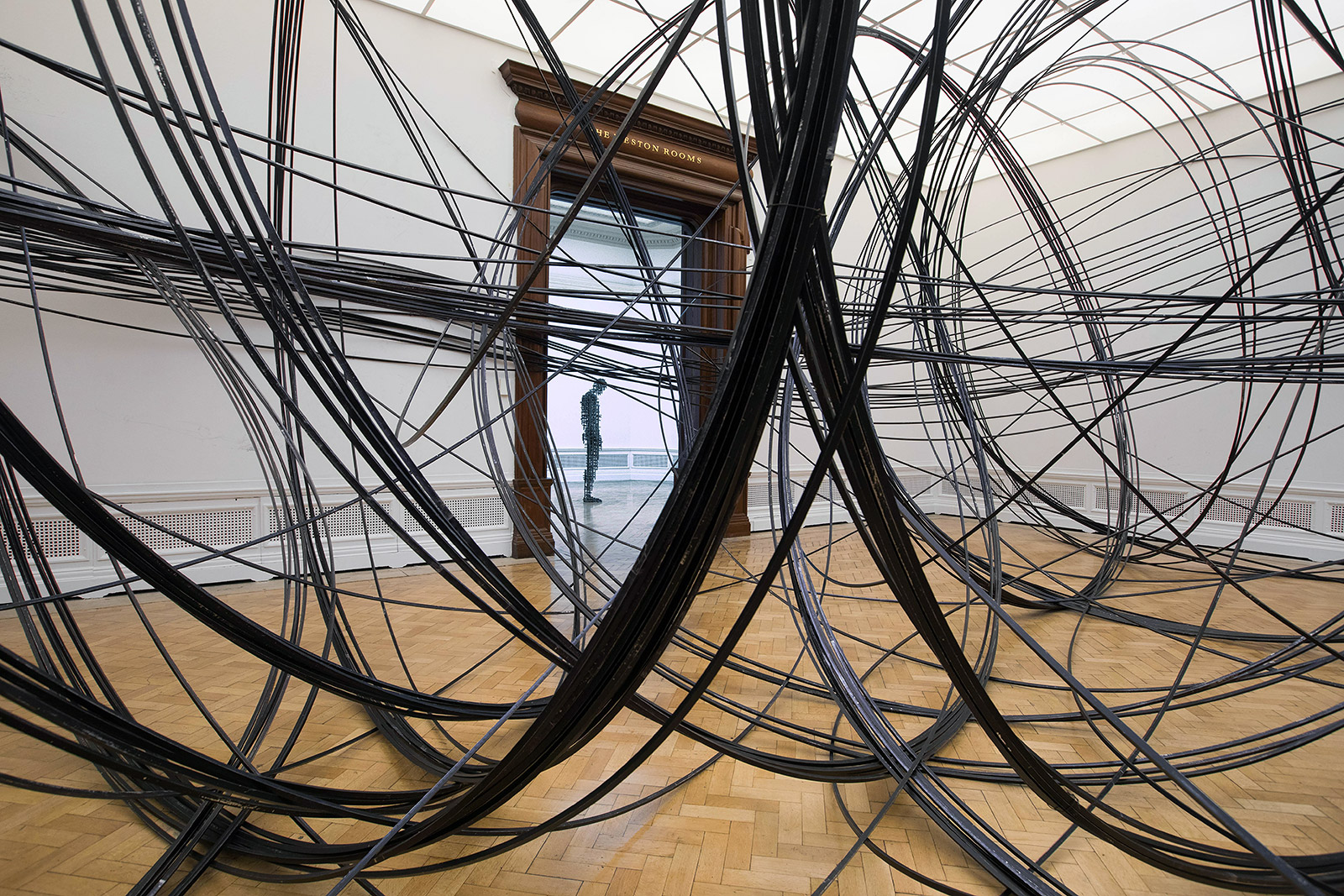 Steel yourself for metal guru Antony Gormley’s Royal Academy blockbuster
Steel yourself for metal guru Antony Gormley’s Royal Academy blockbusterThe British sculptor takes you through a room brambled with steel spindles, inside pitch-black tunnels, before platooning you in a room filled with seawater
By Elly Parsons
-
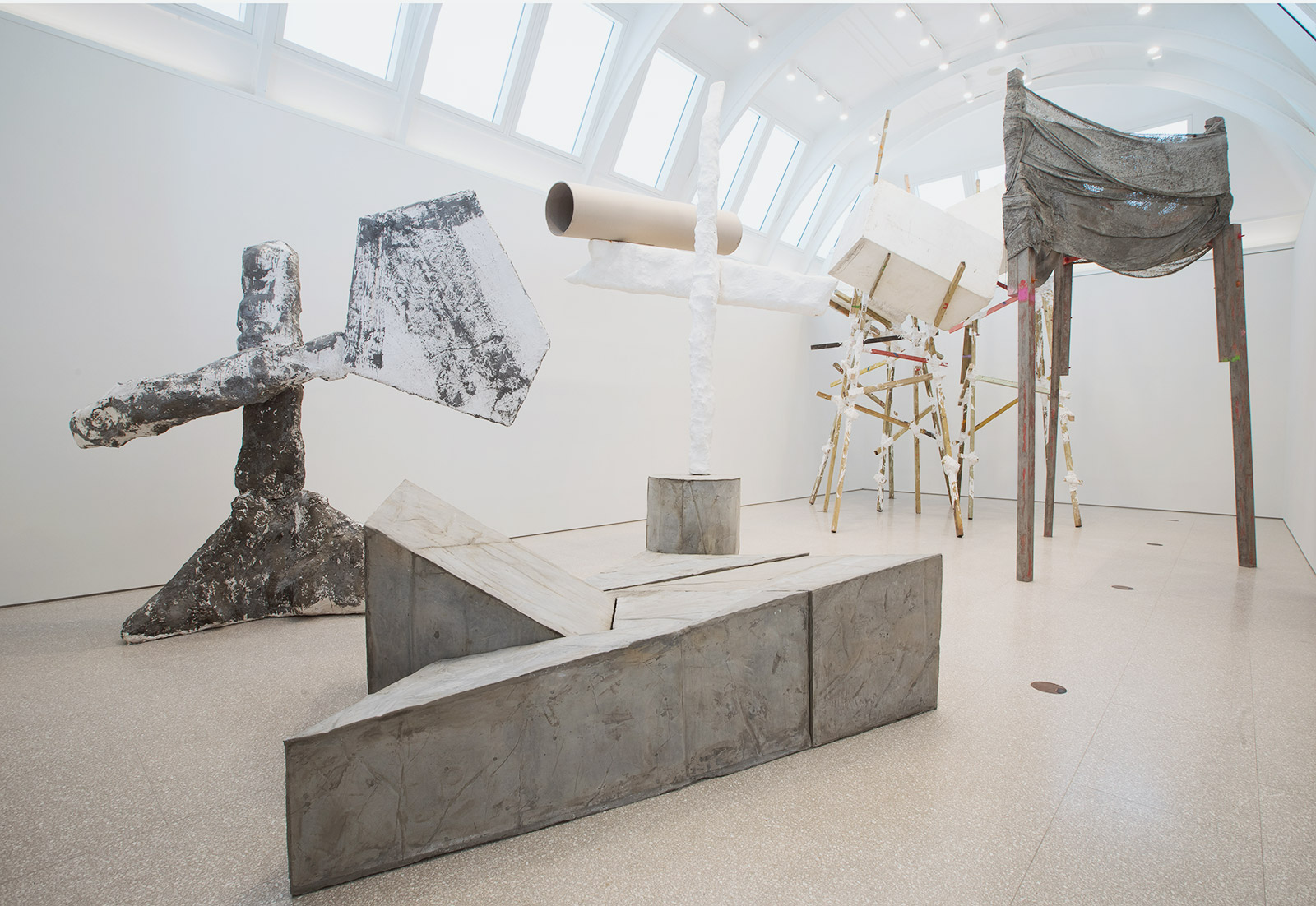 Phyllida Barlow has us on the edge at the Royal Academy
Phyllida Barlow has us on the edge at the Royal AcademyThe British sculptor’s teetering site-specific installations open up new perspectives to the London institution’s architecture
By Louise Long
-
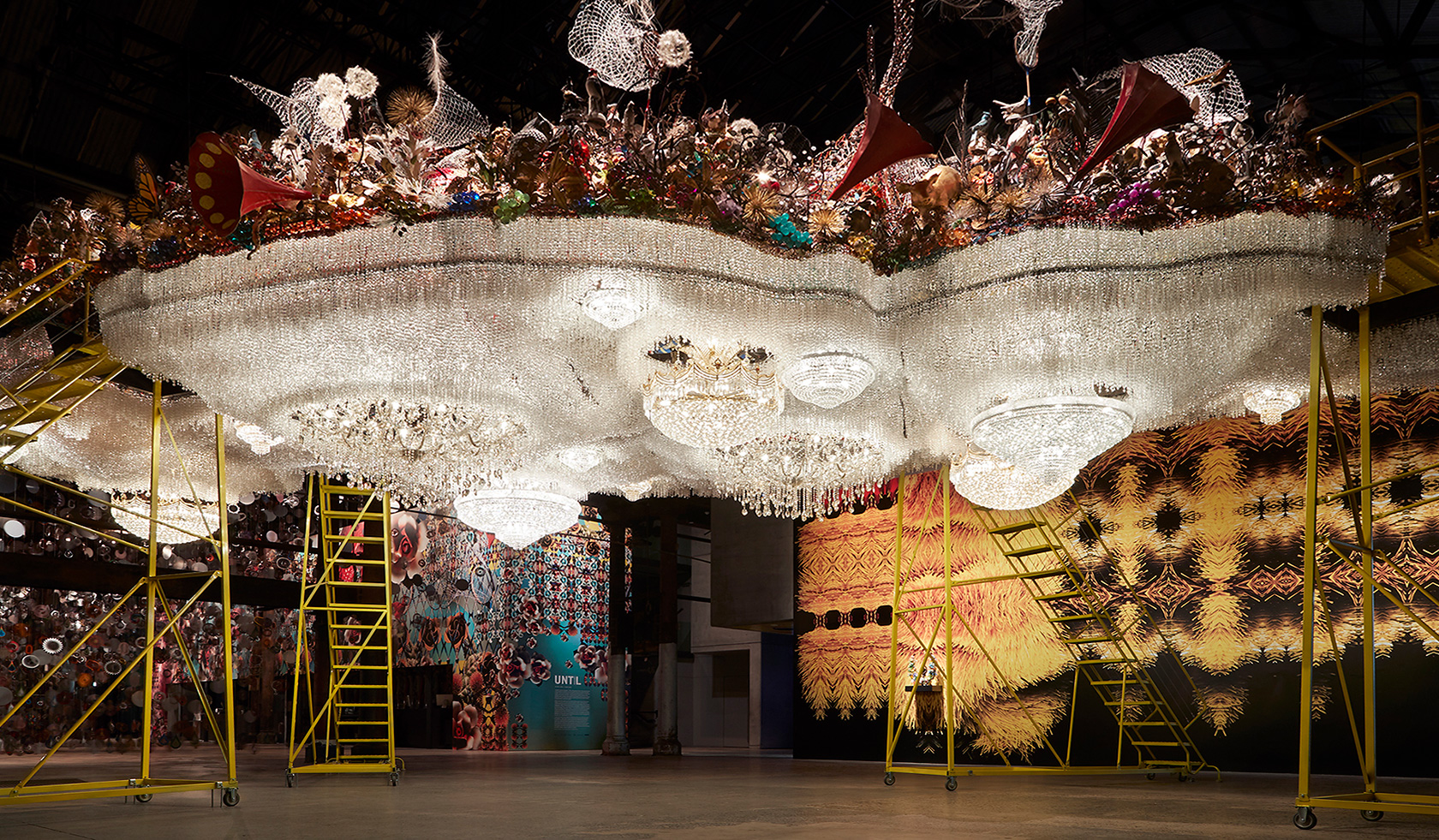 Nick Cave’s colossal crystal cloudscape at Carriageworks imparts a vital message
Nick Cave’s colossal crystal cloudscape at Carriageworks imparts a vital messageBy Dimity Noble
-
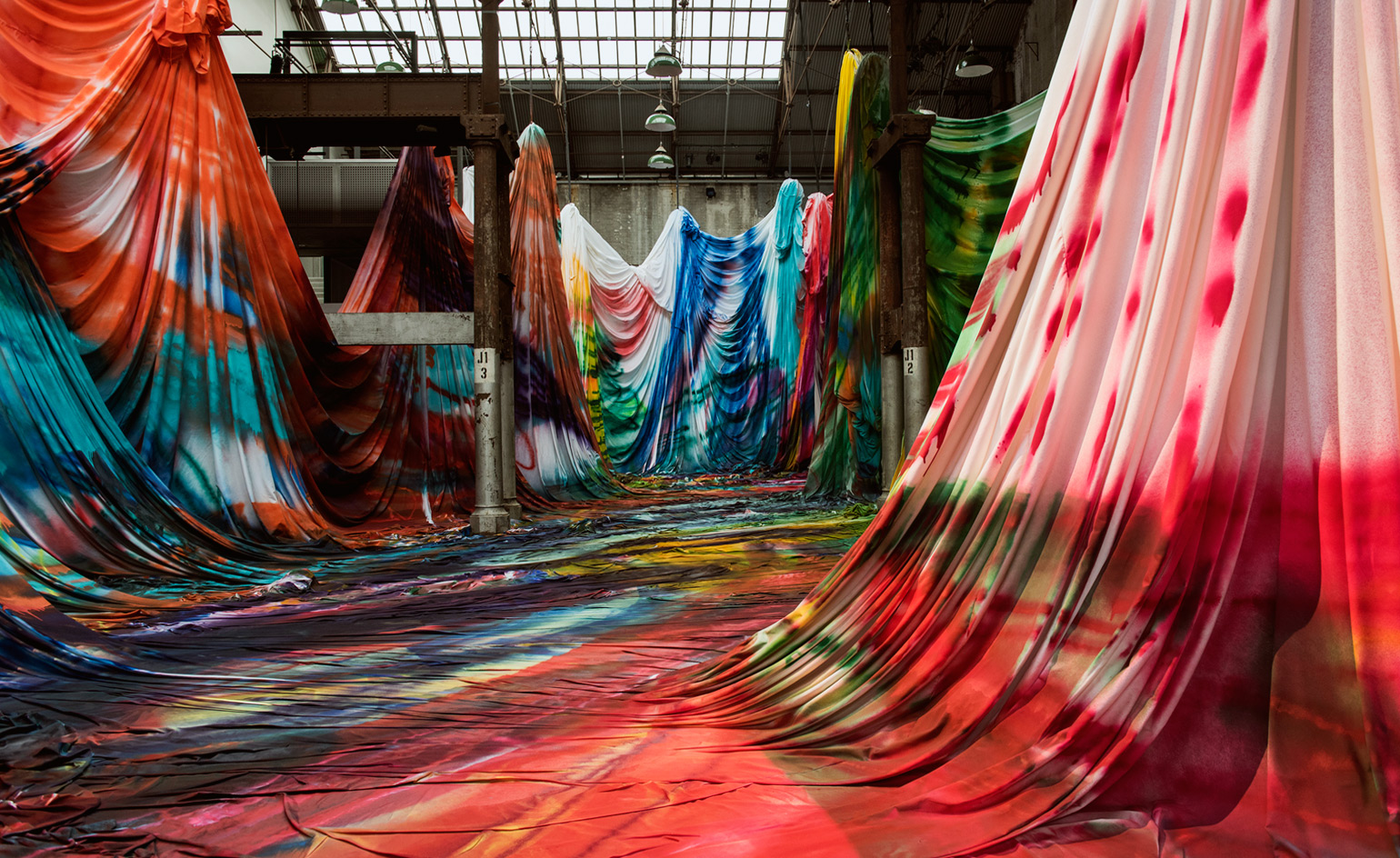 Katharina Grosse steeps Carriageworks in a cacophony of colour
Katharina Grosse steeps Carriageworks in a cacophony of colourBy Dimity Noble
-
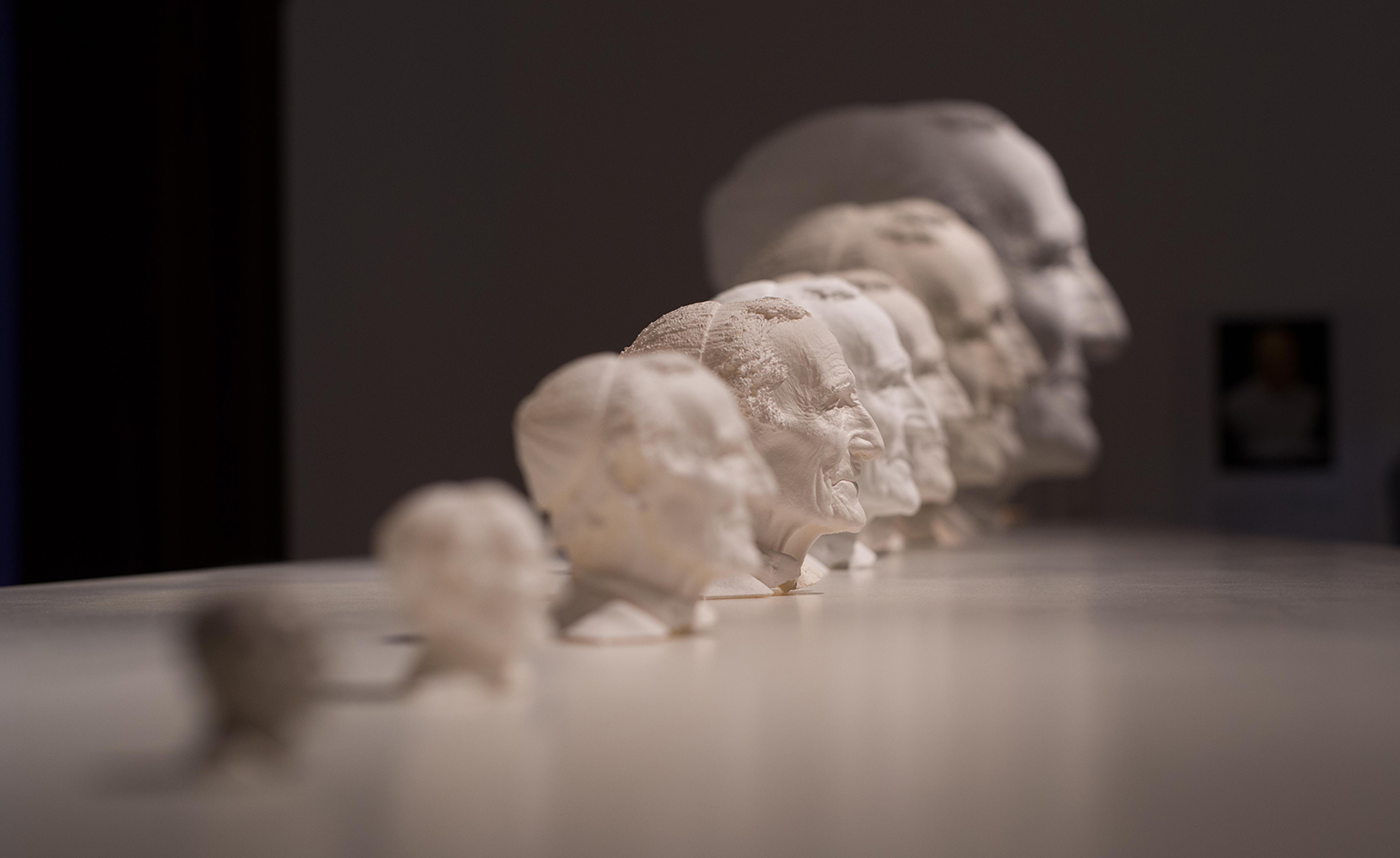 Head trip: the ’Veronica Scanner’ creates live 3D portraits at the Royal Academy of Arts
Head trip: the ’Veronica Scanner’ creates live 3D portraits at the Royal Academy of ArtsBy Elly Parsons